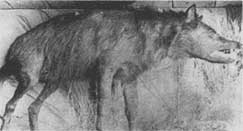
The apparent shunka warak'in shot by Hutchins.
Shunka Warak'in
In the late 19th century, the Hutchins family moved into an
area of Montana along the Madison River's West Fork, in Broadwater County.� They were
soon to report encounters with a mysterious canine beast known to Native Americans.
One of the descendants of the original clan was zoologist Ross Hutchins.� In 1977, he
would write Trails to Nature's Mysteries: The Life of a Working Naturalist.
� Within this book is reference to one of the most obscure creatures to grace North
America's cryptozoological landscape.� The following account is reproduced from that
book.
One winter morning my grandfather was aroused by the barking of the dogs.� He discovered that a wolflike beast of dark color was chasing my grandmother's geese.� He fired his gun at the animal but missed.� It ran off down the river, but several mornings later it was seen again at about dawn. It was seen several more times at the home ranch as well as at other ranches ten or fifteen miles down the valley.� Whatever it was, it was a great traveler...
��� Those who got a good look at the beast described it as being nearly black and having high shoulders and a back that sloped downward like a hyena.� Then one morning in late January, my grandfather was alerted by the dogs, and this time he was able to kill it.� Just what the animal was is still an open question.� After being killed, it was donated to a man named Sherwood who kept a combination grocery and museum at Henry Lake in Idaho.� It was mounted and displayed there for many years.� He called it ringdocus.

The apparent shunka warak'in shot by Hutchins.
An Ioway Indian named Lance Foster approached Loren Coleman in 1995 and informed him of traditions existing in that tribe of an animal called a shunka warak'in ('Carrying-Off-Dogs') which cried like a human when killed.� Foster's descriptions of an animal that looked something like a hyena and the existence of one in an Idaho museum are testimony that the animal killed at the Hutchins ranch was a Shunka Warak'in.�
Coleman speculates that the creature may have represented a survival of a prehistoric species known as Borophagus, although my own researches into the animal makes it seem even more likely that it may belong to another prehistoric species, a creodont known as Hyaenodon montanus.� H. montanus was a rather lightly built memeber of the Neohyaenodon subspecies
COLEMAN, Loren
��� 1996 ���
���� On the Trail: Hunting Hyenas in the US.� Fortean
Times 87 (June).
��� 1999 ���
���� Cryptozoology A-Z (w/ Jerome
Clark).�